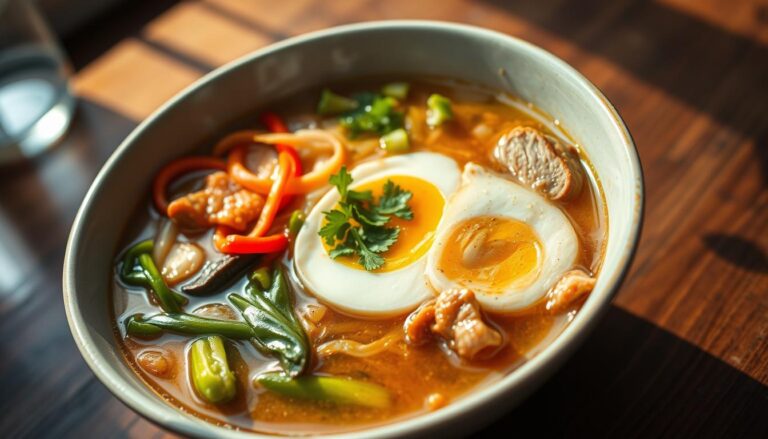Homemade Healthy Ramen: A Flavorful and Nutritious Meal
Looking for a tasty and healthy meal? A homemade ramen recipe is perfect. It turns the classic dish into a nutritious treat, blending old techniques with new wellness ideas.
Ramen is more than just a quick meal. It’s a chance to feed your body with good stuff. You’ll learn to make a broth that’s rich, choose protein-rich toppings, and add fresh veggies to make it even better.
Leave behind the bland, processed noodles. This homemade version brings top-notch flavor to your kitchen. By picking every ingredient yourself, you can make ramen a healthy choice that supports your goals.
The key is choosing the right ingredients. Use fresh veggies, lean proteins, and special broths to make a dish full of nutrients. Whether you’re always on the go or love cooking at home, these tips will change how you see comfort food.
Ready to make a ramen bowl that’s both healthy and yummy? I’ll show you how to do it. You’ll learn every step, making sure your dish is not only tasty but also good for you.
Understanding the Basics of Healthy Ramen Recipe
Ramen has grown from a simple street food to a nutritious meal. Making easy ramen bowls at home lets you turn this classic dish into a health and flavor powerhouse. This change from traditional to modern ramen is a big step towards wellness without losing flavor.
Traditional vs. Modern Healthy Adaptations
Old ramen was often high in sodium and fat. Today, homemade ramen noodles offer a fresh take. The new ramen focuses on:
- Lighter, nutrient-dense broths
- Lean protein sources
- Whole grain or gluten-free noodle options
- Abundant fresh vegetables
Key Components of a Nutritious Ramen Bowl
| Component | Healthy Options | Nutritional Benefit |
|---|---|---|
| Broth | Low-sodium vegetable or bone broth | Reduces sodium intake, supports hydration |
| Noodles | Whole wheat, brown rice, or zucchini noodles | Increased fiber, lower carbohydrate |
| Protein | Tofu, grilled chicken, soft-boiled egg | Muscle support, essential amino acids |
| Vegetables | Spinach, mushrooms, carrots, bok choy | Vitamins, minerals, antioxidants |
Health Benefits of Homemade Ramen
Making easy ramen bowls at home lets you control what goes in. You can cut down on sodium and boost nutrients. Homemade ramen noodles are a blank slate for health and flavor, helping you meet your health goals.
Essential Ingredients for Your Homemade Broth
https://www.youtube.com/watch?v=DOvP16A_bAA
Making a flavorful ramen broth is like creating a work of art. It turns simple ingredients into a dish that’s both delicious and healthy. The trick is to choose the right ingredients that are full of flavor but low in calories.
To make your ramen broth stand out, I’ve found a few key ingredients. These will take your broth from good to great. Let’s look at what makes your homemade ramen special.
- Garlic: 3 cloves, finely minced for depth of flavor
- Ginger: 1 tablespoon, freshly grated
- Dried shiitake mushrooms: 1 ounce, rehydrated
- Low-sodium soy sauce: 1 tablespoon
- White or yellow miso paste: 1 tablespoon
It’s important to know how to mix these ingredients for the best broth. Each one adds its own special taste that makes the broth amazing.
| Ingredient | Flavor Profile | Calorie Impact |
|---|---|---|
| Garlic | Pungent, aromatic | Low (4 calories per clove) |
| Ginger | Spicy, warming | Very low (2 calories per tablespoon) |
| Shiitake Mushrooms | Umami, earthy | Minimal (7 calories per ounce) |
| Miso Paste | Savory, complex | Moderate (30 calories per tablespoon) |
Pro tip: Try different amounts of these ingredients to make your own special broth. The goal is to add lots of flavor without too many calories. Start with a little and adjust until it tastes just right to you.
Choosing the Right Noodles for Your Healthy Ramen
Noodles are the heart of any ramen dish. Picking the right type can make your healthy ramen recipe stand out. Whether you’re looking for gluten-free options or nutrient-dense alternatives, knowing your noodle choices is key to a tasty and healthy meal.
Gluten-Free Ramen Noodle Options
For those avoiding gluten, there are many tasty alternatives:
- Rice noodles: Light and delicate, perfect for gluten-free ramen
- Sweet potato noodles: Rich in nutrients and naturally gluten-free
- Shirataki noodles: Low-calorie, zero-carb option made from konjac root
Traditional Ramen Noodle Alternatives
Try these innovative noodle choices to expand your healthy ramen recipe:
- Whole grain noodles: Packed with fiber and additional nutrients
- Zucchini noodles: Low-carb, vegetable-based alternative
- Buckwheat noodles: Protein-rich and full of essential minerals
Cooking Times and Techniques
Each noodle type needs special preparation for the perfect texture. Here’s a quick guide to help you master your noodle cooking technique:
| Noodle Type | Cooking Time | Preparation Method |
|---|---|---|
| Rice Noodles | 3-5 minutes | Soak in hot water, drain quickly |
| Shirataki Noodles | 2-3 minutes | Rinse thoroughly, pat dry, quick stir-fry |
| Zucchini Noodles | 1-2 minutes | Lightly sauté or serve raw |
Pro tip: Always watch your noodles and test for the perfect al dente texture. Different gluten-free ramen noodles cook faster than traditional wheat noodles. So, keep an eye on them to avoid overcooking.
Building a Nutrient-Rich Broth Base

Making a nutrient-rich broth is key to delicious ramen. A good broth is the base of any tasty ramen. It must have flavor and nutrients.
Let’s make a strong broth for your ramen. We’ll use ingredients that taste great and are good for you.
- Vegetable Base: Carrots, celery, and onions create a flavor-packed foundation
- Umami Boosters: Kombu seaweed and nutritional yeast add complex taste profiles
- Nutrient-Dense Additions: Mushrooms and herbs enhance both flavor and health benefits
Here’s how to make your broth:
- Start with cold water to extract maximum flavor from ingredients
- Simmer slowly to develop rich, layered tastes
- Strain carefully to ensure a smooth, clear broth
Pro tip: Try different veggies and herbs to make your ramen unique. A bit of turmeric or low-sodium soy sauce can make it amazing.
Homemade broth is very flexible. You can make it vegetarian or add protein. It fits any diet.
Protein Options for Your Ramen Bowl
Choosing the right protein is key to a great ramen bowl. It can turn a simple meal into a nutritious feast. Whether you like plant-based or meat options, I’ll show you how to pick and prepare the best proteins for your ramen.
Plant-Based Protein Alternatives
Vegetarian ramen soup fans have many tasty protein choices:
- Tofu: 4 oz, extra-firm, pressed and cubed
- Tempeh: 3 oz, sliced and marinated
- Seitan: 4 oz, thinly sliced
- Edamame: 1/2 cup, shelled
Lean Meat Selections
Meat lovers can choose from these lean proteins:
| Protein Source | Quantity | Preparation |
|---|---|---|
| Chicken Breast | 4 oz | Sliced, grilled |
| Pork Tenderloin | 3 oz | Thinly sliced, seared |
| Lean Beef | 4 oz | Thinly sliced, quickly sautéed |
Preparation Methods
How you prepare your protein matters a lot. For tofu, press it and marinate for 30 minutes. Meat should be cooked quickly at high heat to stay tender. Always slice proteins thinly for even cooking and easy mixing into your ramen.
Fresh Vegetables and Toppings Selection
Making a healthy ramen recipe is more than just the broth and noodles. The veggies and toppings you pick can make your ramen a colorful, nutritious meal. It will please your taste buds and nourish your body.
When picking veggies for your ramen, aim for colors and nutrients. A good ramen bowl should have a mix of fresh, crunchy veggies. They add flavor and important nutrients.
- Leafy Greens: Bok choy, spinach, and kale bring incredible depth and nutrition
- Colorful Additions: Corn kernels, sliced bell peppers, and julienned carrots
- Nutrient-Dense Options: Mushrooms, bean sprouts, and edamame
For a healthier ramen, try these topping combos. They add texture and make your ramen look great:
- Nori strips: Adds umami and marine minerals
- Toasted sesame seeds: Provides crunch and nutty flavor
- Sliced green onions: Brings fresh, sharp notes
- Soft-boiled egg: Adds protein and creamy richness
Pro tip: Add delicate veggies like spinach just before serving. This keeps them fresh and colorful. Your ramen will stay healthy and look amazing.
Mastering the Perfect Soft-Boiled Egg
Soft-boiled eggs make easy ramen bowls into a feast. The secret is in how you cook the egg. You want a creamy yolk every time.
To get the perfect soft-boiled egg, pay close attention. Use fresh eggs from local farms for the best taste.
Timing and Temperature Guide
Cooking eggs is an art that needs precision. Here’s how to do it right:
- Choose large eggs at room temperature
- Use a timer for exact cooking time
- Prepare an ice bath before cooking
| Cooking Time | Yolk Consistency | Recommended Use |
|---|---|---|
| 6 minutes | Jammy and soft | Classic ramen topping |
| 7 minutes | Firmer, less runny | Slightly more set texture |
Storage and Preparation Tips
Make your soft-boiled eggs ahead of time. Store them in cold water in an airtight container for up to two days. This keeps them fresh for your ramen.
- Always use fresh, high-quality eggs
- Create an ice bath immediately after boiling
- Peel eggs carefully to maintain integrity
With these tips, you’ll make your ramen stand out. You’ll impress everyone at dinner.
Flavor Enhancers and Seasonings

Making flavorful ramen recipes is more than just mixing ingredients. The right seasonings can turn a simple dish into a masterpiece. Learning to balance and layer flavors is key to making your ramen stand out.
When picking seasonings for your ramen, consider these important ones:
- Soy Sauce: 1 tsp, low-sodium variety
- Miso Paste: 1 tsp, white or red
- Chili Oil: 1/2 tsp, homemade preferred
- Sesame Oil: 1/2 tsp, toasted
- Rice Vinegar: Few drops for brightness
The secret to great ramen is knowing how these seasonings work together. Miso adds depth, while chili oil adds a hint of heat. Sesame oil brings a nutty taste that complements the broth.
Pro tip: Start with small amounts of seasoning. You can always add more, but you can’t take it away. Taste as you go and adjust to your liking. Try yuzu juice, dried seaweed flakes, and fresh ginger for extra flavor.
Don’t be afraid to try new combinations to make your own unique ramen. The best thing about making ramen at home is you can tailor each bowl to your taste.
Time-Saving Preparation Techniques
Making homemade ramen noodles doesn’t have to take all night. I’ll show you how to make it fast, so you can enjoy a healthy meal quickly.
Efficient Meal Prep Strategies
Getting ready ahead of time is key to quick ramen. Break your prep into simple steps to save time on busy nights.
- Broth Preparation: Make large batches of broth and freeze in 2-cup portions
- Protein Prep: Cook lean proteins like chicken or tofu in advance
- Vegetable Cutting: Wash and pre-chop vegetables for instant assembly
- Seasoning Station: Create pre-measured spice and garnish containers
Quick Assembly Methods
When time is tight, these noodles are perfect for dinner. Just have your ingredients ready to mix in minutes.
- Thaw frozen broth night before
- Reheat pre-cooked proteins
- Boil fresh or pre-cooked noodles
- Layer ingredients in bowl
- Add hot broth and serve
With these tips, making ramen is quick and fun. Spend a bit of time on weekends, and you’ll have tasty ramen bowls in under 15 minutes.
Creative Garnishing Ideas

Turning your ramen into a masterpiece starts with garnishing. I’ll show you expert tips to make your ramen look and taste amazing.
Garnishes do more than just look good. They boost the flavor of your ramen. The right toppings can add texture, depth, and nutrients to your meal.
Top Garnishing Strategies
- Fresh Herbs: Cilantro, green onions, Thai basil
- Crunchy Elements: Toasted sesame seeds, crispy garlic chips
- Pickled Vegetables: Ginger, radish, jalapeños
- Protein Boosters: Soft-boiled egg, crispy tofu
When picking garnishes, think about color, texture, and taste. A sprinkle of bright herbs can turn a simple broth into a gourmet dish.
Texture and Flavor Combinations
| Garnish | Texture | Flavor Profile |
|---|---|---|
| Crispy Garlic Chips | Crunchy | Savory, Intense |
| Fresh Cilantro | Soft, Delicate | Bright, Herbal |
| Pickled Radish | Crisp | Tangy, Sharp |
Pro tip: Arrange your garnishes from lightest to heaviest. Begin with herbs, then add crunchy bits, and top with protein. This way, every bite is full of flavor and fun to look at.
Storage and Reheating Guidelines
Making the perfect healthy ramen recipe is just the start. Keeping your easy ramen bowls fresh and tasty all week is key. Learning how to store each part right can really help keep the flavors and textures great.
It’s important to store different ingredients separately. This helps your ramen stay at its best. Here’s how to store each part of your ramen bowl:
- Broth: Store in an airtight container in the refrigerator
- Noodles: Keep separate from broth to prevent sogginess
- Proteins: Store in sealed containers
- Vegetables: Refrigerate in separate containers
When reheating your easy ramen bowls, be gentle. Quick or high heat can ruin the flavors of your healthy ramen recipe.
| Ramen Component | Refrigeration Time | Reheating Method |
|---|---|---|
| Broth | 3-4 days | Slow simmer on stovetop |
| Noodles | 2 days | Quick dip in hot water |
| Proteins | 2-3 days | Gentle microwave or pan warming |
Pro tip: Always assemble your ramen just before serving. This keeps the texture and temperature perfect. Fresh ingredients and careful reheating make leftover ramen taste like it’s brand new.
Conclusion
Making a healthy ramen at home turns a simple meal into a fun adventure. This guide teaches you how to make ramen that’s both tasty and good for you. Your kitchen becomes a place where you can mix flavors, nutrition, and your own creativity.
Learning to make nutritious ramen takes time and practice. Every bowl is a chance to mix proteins, veggies, and spices in a way that’s both tasty and healthy. Start with the basics, then add your own twist to make it your own.
Homemade ramen is all about being flexible. It’s perfect for a quick dinner or a weekend cooking project. Every choice you make, from the protein to the veggies and spices, makes a difference.
Your ramen journey is just starting. Keep trying new things, tasting, and improving your skills. Each bowl is a chance to learn, enjoy, and celebrate cooking at home. Trust yourself, enjoy the process, and savor every bite.







